Author: Adam Simmons
Date published: August 10th 2023
Table of Contents
Introduction
Recent gaming monitors with 2560 x 1440 (QHD or 1440p) resolution have focused on ~27” and larger screen sizes. For some, a more compact screen is preferable due to space restrictions or simply fondness of the more compact viewing area or higher pixel density for a given resolution. The Q24G2A (Q24G2A/BK owing to the black stand base) of the AOC Gaming ‘G2’ series provides the rare combination of QHD resolution, 23.8” screen size and 165Hz refresh rate. Adaptive-Sync is also supported, providing VRR support for various GPUs and systems. We put this intriguing monitor to the test with our usual objective and subjective analysis, which includes real-world applications such as gaming, video watching and general desktop usage.
Specifications
The monitor adopts a 23.8” IPS (In-Plane Switching) type panel with 2560 x 1440 resolution, which we believe is a BOE IPS-ADS part such as the MV238QHM-NF0. A 165Hz refresh rate and true 8-bit colour is specified. A 1ms grey to grey response time is indicated, as well as a 1ms MPRT response time using the included strobe backlight setting. As usual don’t put too much weight on such figures. Some of the key ‘talking points’ for this monitor have been highlighted in blue below, for your reading convenience.
The monitor offers the typical slightly ‘gamery’ styling of the ‘G2’ series, with extensive use of matte black plastic with a few dark metallic-look red plastic elements. These red elements are better blended by eye than they appear in pictures so don’t really jump out at you. The stand base is matte black plastic with a star-shaped design – 2 longer front legs and 2 shorter rear legs. The top and side bezels are dual-stage, with a slender panel border flush with the rest of the screen plus a thin hard plastic outer part. Including both components the bezels are ~5mm (0.20 inches) at the top and sides. The bottom bezel is ~18mm (0.71 inches) thick, black matte plastic with a light grey AOC logo printed centrally and a dark red metallic-effect bottom lip. The main area of focus from the front is the screen itself, with a light matte anti-glare screen surface used as explored later. The image below is a macro photograph taken on Notepad with ClearType disabled. The letters ‘PCM’ are typed out to help highlight any potential text rendering issues related to unusual subpixel structure, whilst the white space more clearly shows the actual subpixel layout alongside a rough indication of screen surface. This model uses a light matte anti-glare screen surface, which provides decent glare handling without as much layering in front of the image as some matte screen surfaces. And with better maintenance of clarity and vibrancy potential. In very bright conditions and if strong light strikes the screen directly, sharper glare patches can be observed which gives a ‘glassy’ look to the screen. This occurs less than on models we’d classify as having very light matte screen surfaces. The monitor is more prone to ‘hazing’ or ‘flooding’ of the image due to diffused ambient lighting than very light matte and certainly glossy screen surfaces, but less so than medium or stronger matte screen surfaces. The screen surface has a light misty graininess to it, lighter and less course than the sandier or in the worst cases the ‘smeary’ appearance that some matte screen surfaces have. The AOC Q24G2A includes various ‘Game Mode’ presets; ‘FPS’, ‘RTS’, ‘Racing’, ‘Gamer 1’, ‘Gamer 2’ and ‘Gamer 3’. These change various settings in the OSD and lock off access to certain settings. The ‘FPS’, ‘RTS’ and ‘Racing’ presets restrict options in the ‘Game Setting’ and ‘Luminance’ menus, which means brightness is locked at a fairly high level and can’t be adjusted. ‘Overdrive’ is also locked at a predefined level and the ‘Color Setup’ menu is greyed out. The numbered ‘Gamer’ presets allow greater flexibility, but the ‘Color Setup’ menu remains greyed out and various changes are made to colour reproduction which can’t be counteracted. We explore the ‘Game Mode’ presets briefly in the OSD video, as well as so-called ‘HDR Mode’ settings which are just odd image filters that apply to SDR content – this monitor doesn’t respond to an HDR signal. For this table we’ll focus on some of the presets and various manual adjustments. The table below includes white point and gamma readings taken using a Datacolor SpyderX Elite colorimeter, alongside general observations on the image. Our test system uses Windows 11 with an Nvidia RTX 3090 connected using the supplied DP cable. Additional testing was performed using an AMD Radeon RX 580 and using HDMI, although observations for this table didn’t vary significantly between GPUs or inputs. The monitor was left to run for over 2 hours before data was collected and no additional monitor drivers or ICC profiles were specifically loaded. Aside from for our ‘Test Settings’, where various adjustments were made, assume factory defaults were used. When viewing the figures in this table, note that for most PC users ‘6500K’ for white point and ‘2.2’ for gamma are good targets to aim for. Individual targets depend on individual uses, tastes and the lighting environment, however. Out of the box the monitor provided a look we’d describe as ‘rich and natural’, with a slight but not extreme cool tint and slight green channel weakness. Gamma tracked ‘2.1’ on average, with some shades slightly brighter than intended due to reduced gamma. This extended to the darkest shades (aside from black) which were a touch brighter than intended, potentially revealing slight unintended detail for dark scenes in games and movies for example. And for very bright shades which blended into white a bit too readily. This is shown in the first image below, but note that the precision and resolution of the graph is not sufficient to accurately demonstrate the slightly raised gamma for the brightest or darkest shades. Gamma tracking was broadly similar using the ‘sRGB’ setting (second image below), though for medium-dark and dark shades where there was more of an uplift. Gamma more closely tracked the ‘sRGB’ gamma curve than ‘2.2’, so this uplift is expected for dark shades, but it was more widespread in this case and certainly didn’t just affect the darkest shades. With ‘Color Temp.’ set to ‘User’ the monitor averaged ‘2.2’ gamma but deviates somewhat centrally, where gamma is lower and hence some medium shades are brighter than intended. The image below shows the monitor running our ‘Test Settings’, with similar gamma tracking to defaults with the ‘User’ colour temperature setting. It’s again difficult to see given the resolution of the graph, but gamma is more appropriate for the darkest shades which improves the blending and masking of ‘unintended detail’ in darker scenes. Gamma is a bit higher than intended (shades a bit deeper) for some medium-dark shades. Overall, the deviations are not extreme and given the intended uses of the monitor not of great concern – for tighter adherence to the ‘2.2’ curve or where the highest level of colour accuracy is required, a calibration using your own colorimeter or similar device is recommended. This can be beneficial regardless of how good the gamma tracking is on a monitor without calibration. The monitor also includes some ‘LowBlue Mode’ Low Blue Light (LBL) settings, accessible in the ‘Game Setting’ section of the OSD. It would’ve been nice if these could be quickly cycled or enabled and disabled without entering the main menu, but they’re still quite easy to access. The ‘Reading’ mode was particularly effective, significantly reducing blue light output – an effect further strengthened by reducing monitor brightness. Reducing exposure to blue light can aid viewing comfort, whilst the resulting warmer look to the image can be useful for relaxing viewing. Something that could be particularly beneficial in the hours leading up to sleep. The green channel remains relatively strong with these settings as this reduces contrast loss, but also imparts a yellowish green tint. Your eyes adjust to some extent over time, but not entirely. For our ‘Test Settings’ we significantly reduced brightness and made some colour channel adjustments with ‘Color Temp.’ set to ‘User’. Note that individual units and preferences vary, so these settings are simply a suggestion and won’t be optimal for all users or units. We’ve also included the refresh rate used in Windows and our preferred ‘Overdrive’ setting used for most of the review, just for reference. Brightness = 36 (according to preferences and lighting) Color Temp. = User R = 46 G = 50 B = 46 Overdrive = Medium G-SYNC = On Refresh rate (Windows setting) = 165Hz
As an Amazon Associate I earn from qualifying purchases made using the below link. Where possible, you’ll be redirected to your nearest store. Further information on supporting our work.
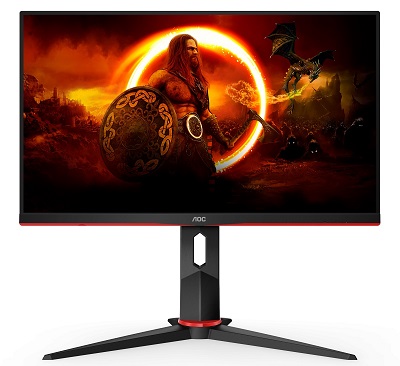
Features and aesthetics


The OSD (On Screen Display) is controlled by pressable buttons on the underside of the bottom bezel, towards the right side. A small forwards-facing power LED is also included in this region, to the right of the buttons. This glows white when the monitor is on and orange when it enters a low power state. The video below explores this menu system and the accompanying ‘G-Menu’ software which can be used to control it. It also explores the changes we made for our ‘Test Settings’, covered later in the review.
The screen is fairly slim from the side; ~12mm (0.47 inches) at thinnest point but lumping out centrally towards the stand attachment point. The stand is fully adjustable including; tilt (4° forwards, 21.5° backwards), height (130mm or 5.12 inches), swivel (30° left and 30° right) and pivot (90° clockwise rotation into portrait). The monitor has a pretty solid overall feel for a budget monitor without excessive wobble when tapped, even if it doesn’t have the same ‘premium’ feel as some models with heavy or metal stands. At lowest stand height the bottom of the screen sits ~55mm (2.17 inches) above the desk with the top of the screen ~377mm (14.84 inches) above the desk. Plus an extra 12mm or so for the top of the stand neck which pokes slightly above the screen top in that position. The total depth of the monitor including stand is ~227mm (8.94 inches), with the screen sitting ~50mm (1.97 inches) back from the front edge of the stand. This is a reasonably compact design which can be accommodated even if you don’t have a particularly deep desk.

The rear combines matte black plastic with a few dark red metallic-looking plastic pieces. Including chevron ‘cheeks’ at the side, a stripe down the centre of the stand neck and a ring at the join between stand neck and base. There’s an elongated hexagonal cable tidy loop towards the bottom of the stand neck. The stand attaches centrally using a quick-release mechanism, with stand released by pressing a switch upwards. Removing the stand reveals provision for 100 x 100mm VESA mounting if you wish to wall mount or use an alternative stand or mounting solution. The ports face downwards and include; HDMI 2.0, DP 1.2, a 3.5mm headphone jack and AC power input (internal power converter). Beneath and slightly to the right of the port area there’s a K-Slot. 2 x 2W speakers are also included, offering basic and not particularly rich or high-quality sound output. The maximum volume is reasonable and the minimum reasonably (though not very) quiet. Regardless of volume some content sounds a bit distorted and not as clear as it should. These speakers are there if you need them and can be useful, but don’t expect beautiful audio. Standard accessories include a power cable and DP cable but may vary regionally.


2560 x 1440 @165Hz plus Adaptive-Sync can be leveraged via DP 1.2, with HDMI 2.0 also supporting Adaptive-Sync but limited to a maximum of 144Hz. AMD FreeSync is supported via DP and HDMI on compatible GPUs and systems with Nvidia’s ‘G-SYNC Compatible Mode’ supported on compatible GPUs via DP. Compatible Intel graphics hardware can also leverage Adaptive-Sync. The images below show the refresh rates supported for the native 2560 x 1440 (QHD or 1440p) resolution via DP. Via HDMI the same refresh rates are listed up to a maximum of 144Hz.

The images below show the refresh rates supported when running in the 1920 x 1080 (Full HD or 1080p) resolution using DP. The first image shows the resolutions categorised in the EDID of the monitor as ‘TV’ resolutions and listed here under ‘Ultra HD, HD, SD’. The second image shows resolutions categorised in the EDID and listed here as ‘PC’ resolutions. Via HDMI the first resolution list is identical and for the second list only 144Hz is listed.


If you’re intending to use the monitor with the PS5 or Xbox Series X/S, be aware that a small settings tweak may be required to ensure 120Hz is selectable for supported resolutions. Details can be found in this article. Note that a ‘4k x 2k, 3840 x 2160’ downsampling mode is not included, so the monitor will not accept a 3840 x 2160 (‘4K’ UHD) signal.
Calibration
Subpixel layout and screen surface
![]()
As shown above the standard RGB (Red, Green and Blue) stripe subpixel layout is used. This is the default expected by modern operating systems such as Microsoft Windows. Apple’s MacOS no longer uses subpixel rendering and therefore doesn’t optimise text for one particular subpixel layout to the detriment of another. You needn’t worry about text fringing from non-standard subpixel layouts and won’t need to change the defaults in the ‘ClearType Text Tuner’ as a Windows user. You may still wish to run through the ClearType wizard and adjust according to preferences, however. The subpixels are slightly ‘squat’ with slightly larger gaps above and below than some models will show. In some cases this contributes to ‘static interlace pattern artifacts’ and can affect text and fine-edge clarity. On this model we observed no such issues, likely as the pixel density is sufficiently high that the gaps above and below the subpixels are still very small. We therefore had no subpixel-related concerns related to sharpness or text clarity on this model.
Testing the presets
Monitor Settings Gamma (central average) White point (kelvins) Notes Gamma1 (Factory Defaults) 2.1 6811K A look we’d describe as ‘rich and natural’, with slight oversaturation in places but less so than wide gamut models. Gamma a touch below target, explored later. A cool tint and slight green channel weakness. Gamma2 1.9 6810K As above with reduced gamma sapping the image of depth and raising dark shade visibility. Gamma3 2.3 6816K As defaults with raised gamma, adding extra depth and crushing some darker shades together too readily. Color Temp. User 2.2 6550K As factory defaults with more appropriate white point and some changes to gamma handling (explored later). Color Temp. sRGB 2.1 6796K An sRGB emulation setting, reducing overextension in the red region of the gamut to reduce oversaturation. Due to gamma handling (described below) and gamut undercoverage some shades look somewhat undersaturated and the look could be described as a bit ‘flooded’ in places. Colour channel imbalances are similar to factory defaults. This is an inflexible setting as brightness, colour channels and gamma are locked. LowBlue Mode = Multimedia 2.1 6311K Though white point is slightly lower than factory defaults and blue light output is marginally reduced, this doesn’t have the effect that a Low Blue Light (LBL) setting should. LowBlue Mode = Internet 2.1 5839K As above, slightly more effective with relatively strong green channel giving a mild yellowish green tint. LowBlue Mode = Office 2.1 5465K As above, more effective as an LBL setting. The blue channel is reduced significantly with strong green channel maintained, so the image appears warm with a yellow to green tint. LowBlue Mode = Reading 2.1 5137K An effective LBL setting with further blue light reduction and significant yellowish green tint. Test Settings (see below) 2.2 6532K As ‘User’ with reduced brightness and modified colour channels to correct slightly weak green channel.
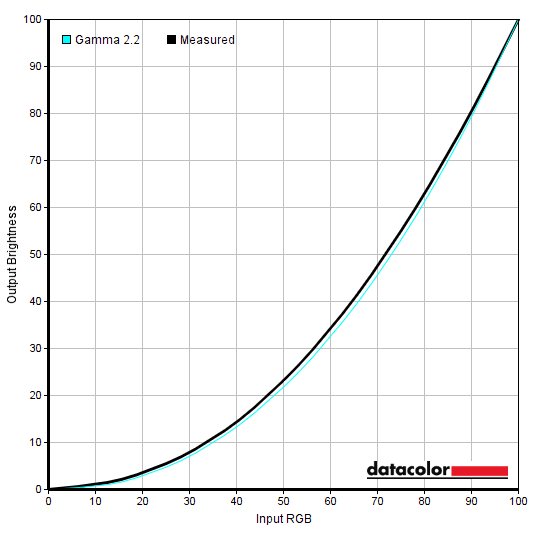
Gamma factory defaults
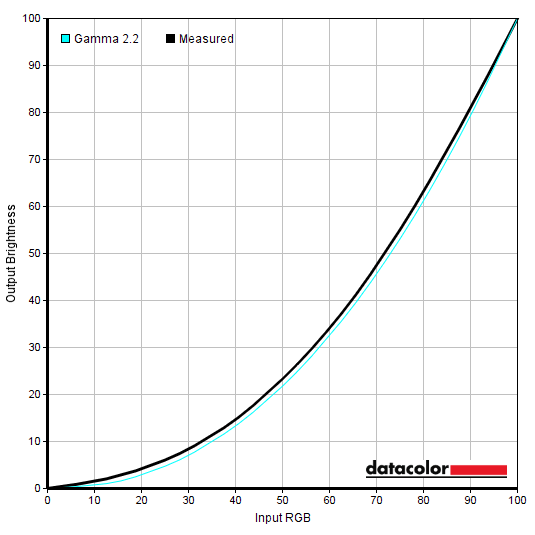
Gamma 'sRGB'
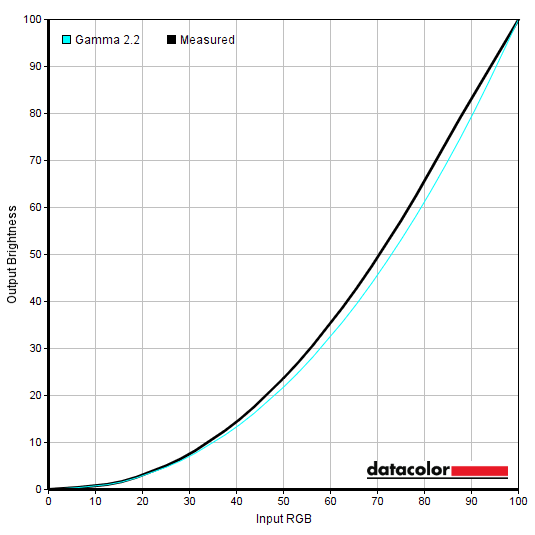
Gamma 'Test Settings'
Given the intended uses for the monitor, inter-unit variation and performance on our unit with OSD tweaking alone we won’t be using any ICC profiles in this review or including any measurements or graphs using them. We wouldn’t recommend using them unless created for your specific unit using your own calibration device. But we appreciate some users still like to use profiles and some aspects such as gamut mapping for colour-aware applications can be useful. You can download our ICC profile for this model, which was created using our ‘Test Settings’ as a base. You can also download our sRGB profile which was created using and designed for the ‘Color Temp. = sRGB’ setting. Note again that these profiles aren’t used in the review.
Test Settings
Contrast and brightness
Contrast ratios
An X-Rite i1Display Pro Plus (Calibrite ColorChecker Display Plus) was used to measure the luminance of white and black using various settings, including those found in the calibration section. From these values, static contrast ratios were calculated. The table below shows the results, with blue highlights indicating the results under our ‘Test Settings’. Black highlights indicate the highest white luminance, lowest black luminance and highest contrast ratio recorded. Assume any setting not mentioned was left at default, aside from the exceptions noted here or in the calibration section.
Measurements using ‘MBR’ were taken at 165Hz – brightness levels were similar at lower refresh rates, so we didn’t feel it was worthwhile documenting these observations on the table.
| Monitor Settings | White luminance (cd/m²) | Black luminance (cd/m²) | Contrast ratio (x:1) |
| 100% brightness | 383 | 0.39 | 982 |
| 80% brightness | 284 | 0.29 | 979 |
| 60% brightness | 213 | 0.22 | 968 |
| 40% brightness | 163 | 0.17 | 959 |
| 20% brightness | 116 | 0.12 | 967 |
| 0% brightness | 64 | <0.07 | >914 |
| Gamma1 (70% brightness, Factory Defaults) | 238 | 0.25 | 952 |
| Gamma2 | 237 | 0.25 | 948 |
| Gamma3 | 237 | 0.25 | 948 |
| Color Temp. User | 248 | 0.25 | 992 |
| Color Temp. User (100% brightness) | 395 | 0.39 | 1013 |
| Color Temp. sRGB | 237 | 0.25 | 948 |
| LowBlue Mode = Multimedia | 235 | 0.25 | 940 |
| LowBlue Mode = Internet | 234 | 0.25 | 936 |
| LowBlue Mode = Office | 232 | 0.25 | 928 |
| LowBlue Mode = Reading | 230 | 0.25 | 920 |
| MBR = 1 | 251 | 0.25 | 1004 |
| MBR = 10 | 175 | 0.18 | 972 |
| MBR = 15 | 132 | 0.14 | 943 |
| MBR = 20 | 91 | 0.10 | 910 |
| Test Settings | 158 | 0.16 | 988 |
The average static contrast with only brightness adjusted was 971:1, close to the specified 1000:1 and fairly typical for an IPS-type panel. This excludes the value for ‘0% brightness’ where rounding throws off the precision too much. The maximum contrast recorded was 1013:1, with a reasonable 988:1 recorded under our ‘Test Settings’. Contrast fell just slightly using ‘LowBlue Mode’ settings, to 920:1 using the strongest ‘Reading’ setting. A similar slight hit was observed using stronger MBR settings. The highest white luminance recorded was 395 cd/m² whilst the lowest white luminance recorded was 64 cd/m². This maximum handily exceeds the specified 350 cd/m² and is quite bright for an SDR monitor. The brightness adjustment range is 331 cd/m² with a reasonably (but not extremely) low minimum – this adjustability should be sufficient for most users.
PWM (Pulse Width Modulation)
The Q24G2A does not use PWM (Pulse Width Modulation) to regulate backlight brightness at any level. Instead, DC (Direct Current) is used to moderate brightness. The backlight is therefore considered ‘flicker-free’, which will come as welcome news to those sensitive to flickering or worried about side-effects from PWM usage. The exception to this is with ‘MBR’ (Motion Blur Reduction) active, a strobe backlight setting which causes the backlight to flicker in sync with the refresh rate of the display.
Luminance uniformity
Whilst observing a black background in a dark room, using our ‘Test Settings’, we noticed moderate backlight bleed and associated clouding, mainly towards the top and bottom right. It’s important to remember that individual units vary when it comes to all aspects of uniformity, including backlight bleed and clouding. The following image was taken a few metres back to eliminate ‘IPS glow’. This was mainly observed as a warm golden haze (or slightly cool silverish haze, depending on angle) which emanates from the corners of the screen. This ‘IPS glow’ blooms out more strongly from steeper angles, as demonstrated in the viewing angles video later. The luminance uniformity was good. The maximum luminance was recorded at ‘quadrant 5’ in the centre of the screen (160.9 cd/m²). The greatest deviation from this occurred at ‘quadrant 9’ towards the bottom right (146.7 cd/m², which is 9% dimmer). The average deviation between each quadrant and the brightest point was 5.75%, which is respectable. Remember that individual units vary when it comes to uniformity and you can expect further deviation beyond the points measured. The contour map below shows these deviations graphically, with darker greys representing lower luminance (greater deviation from brightest point) than lighter greys. The percentage deviation between each quadrant and the brightest point recorded is also given. The SpyderX Elite was also used to analyse variation in the colour temperature (white point) for the same 9 quadrants. The deviation between each quadrant and the quadrant closest to the 6500K (D65) daylight white point target was analysed and a DeltaE value assigned. Darker shades are also used on this map to represent greater deviation from 6500K. A DeltaE >3 represents significant deviation that may be readily noticed by eye. Results here were strong with no significant deviations recorded. The central point was recorded as closest to 6500K with the bottom left showing the greatest deviation (DeltaE 2.4). Note again that individual units vary when it comes to uniformity and that you can expect deviation beyond the measured points. The monitor offered a reasonable contrast performance on Battlefield 2042. The contrast sits at 988:1 under our ‘Test Settings’, so pretty typical IPS territory. This isn’t sufficient to provide strong depth to darker shades or a strong atmosphere with well-defined shadow details. The monitor also has ‘IPS glow’ to contend with, which ‘blooms out’ mainly from the bottom corners of the screen from a normal viewing position. It creates a warm slightly golden haze in that region which eats away at dark detail, but was at a typical level for an IPS model of this size. It’s brought out more strongly if you use a higher brightness level, sit closer to the monitor or have a unit with significant backlight bleed or clouding issues. These weaknesses in contrast performance are most apparent in dimmer lighting, so when your room is dim you may wish to consider bias lighting or lighting behind the monitor to aid perceived contrast and potentially viewing comfort. The screen surface allowed reasonably direct light emission from the screen without obvious layering in front of the image and just a bit of ‘misty’ graininess from the screen surface. We also tested Shadow of the Tomb Raider, which features many scenes where a strong contrast performance is advantageous. Dark caves, passageways and suchlike illuminated by a few point sources of light. The depth and atmosphere provided here was lacking, but in-line with expectations for the IPS-type panel. With the less than amazing static contrast combined with ‘IPS glow’ negatively impacting the representation, particularly when observed in dimmer conditions. A key strength of the IPS-type panel, applying to this title but also more broadly, is strong gamma consistency. Regions affected by ‘IPS glow’ aside, dark detail is maintained in a consistent way throughout the screen. Free from the obvious vertical gradients observed on TN models or masked appearance (‘black crush’) centrally and potentially excessive detail peripherally observed on VA models. The screen surface again provided a superior experience to some matte surfaces without coarse or ‘smeary’ graininess and just a light dusting of grain instead. To round off our subjective testing, we observed the film Star Wars: The Rise of Skywalker. There are plenty of scenes here which look there best on models with strong contrast, with bright bursts of energy lighting up darker surroundings. Things again lacked depth and atmosphere compared to on models with significantly stronger contrast, particularly when observed in a dim room. The film is presented in a ‘letterboxed’ format with black bars above and below the image. The contrast weaknesses are certainly obvious when observing this border, but if the room isn’t dim then these contrast weaknesses are less apparent. Most content streamed on platforms such as Netflix, Disney Plus, Amazon Prime Video and certainly YouTube will be presented in 16:9 without these bars, too. The Lagom tests for contrast allow specific weaknesses in contrast performance to be identified. The following observations were made in a dark room. The colour gamut of the Q24G2A is shown as a red triangle below. It was compared with the sRGB (green triangle) reference colour space using our ‘Test Settings’, as shown in the image below. We recorded 99% sRGB coverage and although not shown in the graphic 80% DCI-P3 coverage and 76% Adobe RGB coverage. There’s slight under-coverage towards the green region and a bit of over-coverage towards the red region. This gives a look we’d describe as ‘rich and natural’, with just a touch of oversaturation to some shades such as reds and oranges but nothing like the oversaturation observed for sRGB content on a wide gamut monitor. The monitor offers an sRGB emulation setting, ‘Color Temp. = sRGB’ in the ‘Color Setup’ section of the OSD. This reduces overextension in the red region of the gamut. It also introduces or increases undercoverage for the green to red edge and green to blue edge – 94% sRGB coverage was recorded. This is an inflexible sRGB setting as key controls including ‘Brightness’, ‘Gamma’ and colour channel adjustments are locked off. ‘Overdrive’ is still adjustable and ‘MBR’ can be used. To maximise colour accuracy within the sRGB colour space, for colour-managed workflows, full calibration and profiling with a colorimeter or similar device using the full native gamut is recommended. You may try the ICC profile featured in the calibration section which includes gamut mapping for colour-aware applications, but best results are always obtained by calibrating your own unit with your own hardware. Instead of using this ‘sRGB’ setting and putting up with the associated restrictions, AMD users can activate a flexible sRGB emulation setting via the graphics driver. This is done by opening ‘AMD Software’, clicking ‘Gaming’ and clicking on ‘Display’. You should then ensure that the ‘Custom Color’ slider to the right is set to ‘Enabled’ and ‘Color Temperature Control’ set to ‘Disabled’. It may appear to be set this way by default, but the native rather than restricted gamut is likely in play. If that’s the case, simply switch the ‘Color Temperature Control’ slider to ‘Enabled’ then back to ‘Disabled’ to leverage the sRGB emulation behaviour. This setting is shown in the image below. The gamut below shows results using our ‘Test Settings’ with this driver tweak applied. The colour gamut now covers 93% sRGB with slightly wonky tracking, providing some undercoverage towards the green region and also blue to red edge, with slight overcoverage for other red shades. This driver setting still offers reasonable tracking of sRGB and helps to cut down on the colour gamut without profiling, including in applications that aren’t colour managed. And you don’t have to put up with restrictions associated with the monitor’s sRGB emulation setting such as locked brightness and colour channels. Whilst Nvidia doesn’t have a similar option in their graphics driver, a third party tool called ‘novideo_srgb’ can be used. This provides a similarly effective GPU-side gamut clamp to the AMD driver option. The resulting gamut was very similar to that shown above with the AMD tweak – this is expected given it uses the same data from the EDID of the monitor. The tool and its usage is covered in our sRGB emulation article. The monitor provided a look we’d describe as ‘rich and natural’ on Battlefield 2042. The gamut of the monitor corresponds relatively closely to sRGB, which is the colour space most content you consume is designed around. There’s a bit of extra extension towards the red region, giving a bit of extra ‘pop’ (saturation) to red-biased shades. This meant elements such as roaring fires and painted red objects looked a bit more vivid than intended, but the push here wasn’t as extreme as it is on wide gamut models. Skin tones, woody tones and earthy browns remained fairly neutral without the stronger red push observed on those models. The in-game environments looked appropriate with a good range of greens – some of the deep and lush shades weren’t as eye-catching as you might observe with a wider gamut and the more muted shades appeared more appropriate in comparison. Sky blues also appeared with more appropriate saturation, rather than looking cartoonish as they can on some models. Similar observations were made on Shadow of the Tomb Raider. Environments looked largely ‘as intended’ and skin tones appeared appropriately neutral rather than overly rich, tanned or sun-kissed. There was again a slight red push due to a bit of extension in the gamut there, but it was more of a subtle boost than you’d see on wide gamut models and didn’t cause heavy oversaturation. Some of the orange and red flowers, fires and painted artifacts in the game had a bit of extra vibrancy as a result. If you wish to cut down on this overextension you could use the ‘sRGB’ setting of the monitor, or alternative sRGB emulation if you want extra flexibility with monitor settings. On both titles and also more broadly the strong colour consistency helped ensure the ‘rich and natural’ look was maintained throughout the screen. Unlike on VA models where there are saturation losses peripherally and TN models where there are clear vertical shifts. We also observed various episodes of the TV series Futurama. As an animated series, there are large areas of individual shade on the screen helping highlight weaknesses in colour consistency in a particularly obvious way. The monitor performed well here, with only minor shifts for some shades. The red of Dr Zoidberg, for example, looked just a touch duller near the extreme edges of the screen and Leela’s purple hair appeared with just a slightly stronger pink tint peripherally. These shifts were significantly lower than you’d observe on VA or TN models. The gamut meant that pastel shades were displayed more appropriately than on wide gamut models, without obvious oversaturation (just a touch for red-biased shades). It also meant that bright and neon shades weren’t as eye-catching, though still had a reasonably vivid look nonetheless. The image below shows a printed reference sheet of 24 ‘sRGB’ shades, included as part of the Datacolor SpyderCHECKR 24 package. The screen is displaying reference photographs of this printed sheet, in both the same order as printed (right side) and reverse order (left side). The camera is mounted slightly above centre so that the image is representative of what the eye sees from an ergonomically correct viewing position. This, coupled with the inclusion of a flipped version of the shade sheet, allows both accuracy and colour consistency to be visually assessed. Bracketed numbers in our analysis refer to shades on the printed sheet or right side of the screen if they’re ordered consecutively from top left to bottom right. Note that there is always some disparity between how emissive objects (monitor) and non-emissive objects (printed sheet) appear. The monitor is set to a very low brightness to help minimise this disparity. The representation of shades in this image depends on the camera and your own screen, it’s not designed to show exactly how the shades appear in person. It still helps demonstrate some of the relative differences between the original intended sRGB shade and what the monitor outputs, however. Full profiling and appropriate colour management on the application would provide a tighter match, our intention here is to show what can be expected in a non colour-managed environment. Interlaced lines in this image are moiré from the camera, not from the monitor itself. The monitor represents things largely as intended, though the gamma behaviour in part causes some shades to be brighter and potentially less saturated than intended, with the gamut adding some extra pop in places. Medium orange (3), Persian pink (6) and Tango pink (11) are a bit bright and undersaturated, though this is exaggerated somewhat in the photo. Lemon yellow (10) appears a bit brighter than intended and gamboge (23) verges too much on a mustard yellow rather than the richer orange-yellow intended. Candy apple red (14) is a bit brighter and more eye-catching than intended, but not to the extent seen on models with a more generous gamut. Grey blue (16) appears a bit livelier and bluer than it should as well, but most of the remaining shades are represented well – overall, the deviations explored here are not as significant as on models with a more generous gamut. Colour consistency is strong overall, without the clear saturation shifts observed on VA or TN models depending on the on-screen position of the shade. There are slight shifts in places for uniformity reasons, for example light chocolate brown (24) appears richer with a slight red push towards the bottom right but more neutral and slightly too cool towards the top left. This discrepancy between the top left and bottom right is less noticeable by eye than it appears in the photo. As explored earlier, the monitor includes an sRGB emulation mode which is locked to a moderately high brightness. The comparison between printed sheet and the screen is massively skewed and captured poorly unless the monitor’s brightness can be set fairly low. So we won’t be including any photos using this setting and the SpyderCHECKR 24 test. As usual, we’d recommend profiling the monitor with your own colorimeter or spectrophotometer using the native gamut if you require the strongest level of colour accuracy. Lagom’s viewing angle tests help explore the idea of colour consistency and viewing angle performance. The following observations were made from a normal viewing position, eyes ~70cm from the screen. The slight shifts noted here are more readily apparent if sitting closer and less apparent if sitting further away. On some monitors, particularly but not exclusively those with high refresh rates, interlace patterns can be seen during certain transitions. We refer to these as ‘interlace pattern artifacts’ but some users refer to them as ‘inversion artifacts’ and others as ‘scan lines’. They may appear as an interference pattern, mesh or interlaced lines which break up a given shade into a darker and lighter version of what is intended. They often catch the eye due to their dynamic nature, on models where they manifest themselves in this way. Alternatively, static interlace patterns may be seen with some shades appearing as faint horizontal or vertical bands of a slightly lighter and slightly darker version of the intended shade. We did not observe either artifact type on this monitor. We didn’t observe any static interlace patterns on this model, but we observed dynamic ‘interlace pattern artifacts’ under certain conditions. Fine interlaced vertical lines could be seen during movement or when scanning our eyes across the screen at times. They were difficult or impossible to see at relatively high refresh rates (e.g. 120Hz+), but more noticeable though not extreme at lower refresh rates such as 60Hz. They were observed in a similar fashion regardless of VRR being active and regardless of ‘Overdrive’ setting. Not everyone will find them bothersome or necessarily notice them even at lower refresh rates. A sensitive camera and a utility called SMTT 2.0 was used to analyse the latency of the Q24G2A. Over 30 repeat readings were taken to help maximise accuracy. Using this method we calculated 1.55ms (~ 1/4 of a frame at 165Hz) of input lag and recorded similar values at lower refresh rates including 60Hz. This was with ‘Low Input Lag’ enabled, which is greyed out and forcefully enabled with ‘G-SYNC’ (the Adaptive-Sync toggle) active in the OSD. This indicates an exceptionally low signal delay which shouldn’t be bothersome even for sensitive users. Note that we don’t have the means to accurately measure input lag with VRR technology active in a VRR environment. Our article on responsiveness explores various factors affecting monitor responsiveness. A key concept explored is ‘perceived blur’, contributed to by both the pixel responses of the monitor and movement of your eyes as you observe motion on the screen. This second factor dominates on modern monitors, but both factors play an important role. A photography technique called ‘pursuit photography’ is also described, using a moving rather than stationary camera to capture motion on the screen in a way that reflects both parts of perceived blur. Rather than only reflecting the pixel response element. The images below are pursuit photographs taken using the UFO Motion Test for ghosting, with the test running at its default speed of 960 pixels per second. This is a good practical speed to take such photographs at and highlights both elements of perceived blur well. The UFOs move across the screen from left to right at a frame rate matching the refresh rate of the display. All three rows of the test are analysed to highlight a range of pixel transitions. The monitor was tested at 60Hz (directly below), 120Hz, 144Hz and 165Hz using various ‘Overdrive’ settings. The final column shows the Gigabyte M27Q for reference, an IPS model which provides a decent performance level most are comfortable with. Note that any wavy patterns surrounding some UFOs in the background are slight image retention. We observed a bit of image retention when running this test and this is something we’ve seen on various monitors before. It soon disappeared when using monitor normally and wasn’t something we observed forming outside of tests like this. At 60Hz, above, the UFO appears soft and unfocused without clear internal detailing. This reflects a moderate amount of perceived blur due to eye movement. Trailing is observed in places behind the UFO, due to weaknesses in pixel response time or overshoot (inverse ghosting) from aggressive pixel overdrive. With the ‘Off’ setting there’s a bit of ‘powdery’ trailing with quite a bold initial section to the trailing, especially for the dark background (top row). This can be observed to some extent for the medium background (middle row) but is much fainter for the light background (bottom row). The ‘Weak’ setting significantly cuts this down but replaces it with light overshoot, ‘halo’ trailing that’s a bit brighter than the background shade. The reference screen performs some way between the ‘Off’ and ‘Weak’ setting. The ‘Medium’ setting causes significantly stronger overshoot that’s particularly colourful and eye-catching, with ‘Strong’ intensifying that further. In practice we found ‘Weak’ optimal at 60Hz, including when observing a broader range of transitions than shown here. Some may prefer the ‘Off’ setting if they’re particularly sensitive to overshoot. Below you can see how things appear with refresh rate doubled to 120Hz. At 120Hz, above, the UFO appears significantly narrower with clearer internal detail. This reflects a significant decrease in perceived blur due to eye movement. To the eye the black lines which separate the segments of the UFO are less blended than they appear in the photos at 120Hz and above, so segmentation is more distinct. The pixel response requirements for a good performance here are significantly increased. The initial section of the trailing using the ‘Off’ setting is now bolder and the ‘powdery’ trailing somewhat denser, though performance is similar if not slightly stronger in places compared to the reference screen even with this setting. The ‘Weak’ setting cuts down on the ‘powdery’ trailing, with a little remaining particularly for the dark background. Overshoot is introduced, but it’s faint and less eye-catching than at 60Hz. The ‘Medium’ setting intensifies this overshoot somewhat, though not to the levels observed using the same setting at 60Hz. The ‘Strong’ setting provides strong and obvious overshoot. We consider ‘Weak’ optimal at 120Hz, though ‘Medium’ could be considered acceptable depending on overshoot sensitivity. Below you can see how things look with a slight bump in refresh rate to 144Hz. At 144Hz, above, the UFO appears very slightly narrower with slightly better definition. This reflects a slight reduction in perceived blur to eye movement, but nowhere near as significant as the initial boost from 60Hz to 120Hz – this is only an extra 24Hz. The pixel response requirements for optimal performance have stepped up further. Overall the trailing behaviour for the respective overdrive settings is quite similar to 120Hz, with a bit of an increase in ‘powdery’ trailing in places with the ‘Off’ and ‘Weak’ settings and slight reduction in overshoot compared to 120Hz using the ‘Medium’ setting. The reference screen is outperformed even using the ‘Off’ setting of the AOC. We consider ‘Weak’ or ‘Medium’ optimal here depending on overshoot sensitivity, but ‘Strong’ may even appeal to some competitive gamers if overshoot isn’t too bothersome to them – it’s less extreme now than at 60Hz, for example. Below you can see things bumped up again to 165Hz. At 165Hz, above, the UFO appears very slightly narrower again with slightly better definition. This reflects a slight reduction in perceived blur to eye movement, but again a minor incremental improvement. The pixel response behaviour is quite comparable to at 144Hz overall, again the pixel response requirements are increased so some of the ‘powdery’ trailing is a touch bolder or more extended. The monitor again outperforms the reference even using the ‘Off’ setting. The overshoot levels are also reduced, with little visible using the ‘Medium’ setting. In practice there are some transitions which will show a bit more overshoot using ‘Medium’ than can be seen here, but as we explore subjectively shortly it pretty tame overshoot really. We consider ‘Medium’ optimal at 165Hz, but depending on overshoot sensitivity other options could be considered. As well as increasing refresh rate to minimise perceived blur due to eye movement, the monitor offers an alternative in the form of ‘MBR’ (Motion Blur Reduction). This is a strobe backlight setting that causes the backlight to pulse at a frequency matching the refresh rate of the display – 120Hz, 144Hz or 165Hz. Sensitivity to this flickering varies and some may find it bothersome whilst others will notice accelerated eye fatigue when using the setting, even if the flickering isn’t actively bothersome to them. The pursuit photographs below were taken with the monitor set to 120Hz using MBR. A few reference screens are also shown for comparison, using their respective strobe backlight settings at 120Hz. The AOC C24G1 using MBR (Motion Blur Reduction) and set to what we consider its optimal setting for that. And the Dell S2417DG using ULMB (‘Ultra Low Motion Blur’). Note that the ‘Overdrive’ setting can be adjusted under MBR. Our preference was for either ‘Medium’ or ‘Strong’ depending on refresh rate, so we’ve included an analysis of both settings here. Also be aware that setting the ‘Overdrive’ to ‘Boost’ is equivalent to using the ‘Strong’ setting and setting ‘MBR’ to ‘20’. With MBR active at 120Hz, above, the main object appears significantly narrower with clearer internal detailing. This is most noticeable for ‘MBR = 20’ where segmentation is distinct and the white notches can be counted. This more focused look to the object with more distinct and clear internal detailing indicates a significant decrease in perceived blur due to eye movement, the main goal of a strobe backlight setting like this. Although intermediate steps aren’t included in this analysis, we found the main object and internal detail clarity particularly strong at a setting of ‘MBR = 15’ and above. Some trailing is visible behind and in some cases in front of the object, fragmented due to the strobe nature of the backlight. The all-encompassing term ‘strobe crosstalk’ is used to describe this fragmented trailing around the object. Because not all areas of the screen refresh simultaneously, the appearance of strobe crosstalk can differ depending on how high up or low down on the screen the movement is being observed. This strobe crosstalk basically melds into the main object and creates what appears to be a duplication using ‘MBR = 1’ so that setting is a bit messy. Overall, the level of strobe crosstalk observed here for ‘MBR = 20’ is reasonable as it remains less bold than the main object. The ‘Strong’ overdrive setting replaces some of the fragmented trailing with overshoot fragments. We found the overshoot a bit too eye-catching at 120Hz using the ‘Strong’ setting for some transitions not shown here and felt ‘Medium’ was better balanced. The images below show results with MBR active at 144Hz. Results here are quite comparable to at 120Hz, with slightly stronger trailing fragments behind the UFOs in some cases. In both cases (120Hz and 144Hz) remember that the segmentation is a bit more distinct than it appears in the photos, but there’s still a slight relative improvement at 144Hz vs. 120Hz. Below you can see things bumped up again to 165Hz. With MBR active at 165Hz, above, there’s a further increase to the clarity of the main object, with the white notches clearly countable and the black segmentation very distinct and clearly defined (slightly more so by eye). This is applicable to higher MBR settings such as ‘MBR = 20’ shown here, at least. The aliasing at the edges of the UFOs can also be clearly seen due to the very strong motion clarity. Although not so clear for these transitions, the overshoot levels were generally reduced a bit by eye when using the ‘Strong’ setting compared to at lower refresh rates and we slightly preferred this setting for overall motion clarity with high MBR settings. As noted earlier, it’s important to note that strobe crosstalk varies at different areas of the screen. Not all areas refresh simultaneously, so its appearance can differ depending on how high up or low down on the screen movement is being observed. The image below is a pursuit photographs with UFOs running along various sections of the screen from top to bottom. Note that the image below is designed to show strobe crosstalk behaviour and doesn’t accurately show how distinct details on the main object appear. The overdrive setting didn’t affect the bold strobe crosstalk further down the screen assessed here. This was also similar for lower refresh rates, with performance centrally assessed earlier for 120Hz, 144Hz and 165Hz – so we’ve only included this single image to represent strobe crosstalk behaviour at different points of the screen. The monitor was set to our preferred settings noted before (‘MBR = 20’ with overdrive set to ‘Strong’ for 165Hz). Further up the screen you can see a bit of strobe crosstalk in front of the UFO, but centrally there’s very little strobe crosstalk with it displaced behind the UFO just below centre. Further down the screen this strobe crosstalk behind the screen becomes rather bold and basically melds into the main UFO as it’s about as bold. Overshoot is visible throughout the screen – it’s not extreme overshoot and for some transitions less obvious than it appears here, so it’s not necessarily going to be distracting when gaming. Overall, the decent levels of strobe crosstalk centrally and lack of extreme overshoot meant this setting has good potential. Remember that the central region is where your eyes mainly focus when playing games such as fast-paced FPS titles that see most potential benefit from such a setting. Remember that wavy patterns in the background are slight image retention, only observed in tests like this and which went away when using the monitor normally. On various Battlefield titles, with the frame rate keeping up with the 165Hz refresh rate, the monitor provided a fluid experience. The monitor outputs up to 2.75 times as much visual information per second as a 60Hz monitor (or this running at 60Hz / 60fps). This significantly improves the ‘connected feel’, which describes the precision and fluidity felt when interacting with the game. The exceptionally low signal delay of the monitor also helps in this respect. The high frame and refresh rate combination also reduces perceived blur due to eye movement, as demonstrated using Test UFO earlier on. This provides a competitive edge by making it easier to track and engage enemies, whilst some will find the gaming experience or simply general usage of the monitor more comfortable. Pixel responses are also important to consider, which as covered earlier were quite strong on this model. Using our preferred ‘Medium’ setting (for 165Hz), there was just a touch of ‘powdery’ trailing. It was most significant where bright shades stood against a contrasting background, but even then was not extreme and was far from the clearer weaknesses observed on VA and even some IPS models. There was a bit of overshoot in places, mainly observed as ‘halo’ trailing that was somewhat brighter than the background. We didn’t find this to be strong and eye-catching overshoot, but sensitivity varies and some people prefer this to be minimised. The ‘Weak’ setting may be preferred to tone this down – it increases ‘powdery’ trailing though not to an extreme degree. Similar observations were made on Shadow of the Tomb Raider. There are plenty of high contrast scenes here where the weakest pixel responses of the monitor can be observed. And again, it was ‘powdery’ trailing that stuck reasonably close to the object and was not too bold – so more subtle than the weaknesses observed on slower IPS models and typical VA models. No ‘smeary’ trailing or anything close to that. There was some overshoot that we’d say was generally quite tame and not strong or eye-catching, but the ‘Weak’ overdrive setting is again an option if you need it. We also observed video content at a range of refresh rates, including ~24 – 30fps content on platforms such as Netflix, Disney Plus and Amazon Prime Video as well as 60fps content on YouTube. Aside from a little overshoot in places (essentially removed using the ‘Weak’ setting) there were no real weaknesses from the pixel responses of the monitor. The main barrier to fluidity was the frame rate of the content itself rather than weaknesses related to the pixel responses of the monitor. As an Amazon Associate I earn from qualifying purchases made using the below link. Where possible, you’ll be redirected to your nearest store. Further information on supporting our work. Earlier in the review we covered ‘MBR’, including its principles of operation and how it performs using specific tests. When using a strobe backlight feature such as this, your frame rate should ideally match the refresh rate precisely. Otherwise you can be left with extremely obvious stuttering or juddering. Standing out in such a clear way due to there being very little perceived blur due to eye movement to mask it. You can’t use Adaptive-Sync at the same time, so you’re at the mercy of potential frame rate fluctuations. We tested a range of titles using the technology but will simply focus on Battlefield titles for this section as they provide a suitable test bed. Our observations here are based on our preferred setting of ‘20’ for MBR, but we felt clarity was strong above a setting of ‘15’ or so and you should experiment to find your own sweet spot for brightness and clarity. We mainly made observations at 165Hz, though broadly similar observations were made at lower refresh rates such as 120Hz. Overshoot levels are increased a bit at lower refresh rates, flickering becomes more noticeable and ‘connected feel’ takes a slight hit due to the reduced refresh rate. The main purpose of the technology, to reduce perceived blur due to eye movement, was achieved. The clarity and details found on various objects during movement was superior, which can give a nice competitive edge when gaming. Making it easier to track and engage enemies even during rapid character movement and manoeuvring in vehicles for example. Some central strobe crosstalk was observed, strongest but still not extreme for brighter objects. It was generally significantly fainter than the main object so didn’t prevent MBR from achieving its main goal and didn’t prove hugely distracting. Your eyes mainly focus on the central region when gaming competitively, but strobe crosstalk further up and moreover down the screen was quite strong as explored earlier. There was a moderate amount of overshoot that was fairly bright for some transitions using our preferred ‘Strong’ setting (for 165Hz strobe operation), but we didn’t find this generally distracting enough to detract from the purpose of the MBR setting. Because KSF phosphors aren’t used for the backlight of the monitor, we didn’t observe the colourful flashes and fringes associated with this when using a strobe backlight setting. Overall, whilst this setting wasn’t perfect and the lack of VRR support, flickering and moderate to strong strobe crosstalk in places isn’t ideal. But overall, it’s a decent strobe backlight implementation with quite a good brightness adjustment range that some will find very useful. AMD FreeSync is a variable refresh rate technology, an AMD-specific alternative to Nvidia G-SYNC. Where possible, the monitor dynamically adjusts its refresh rate so that it matches the frame rate being outputted by the GPU. Both our responsiveness article and the G-SYNC article linked to explore the importance of these two elements being synchronised. At a basic level, a mismatch between the frame rate and refresh rate can cause stuttering (VSync on) or tearing and juddering (VSync off). FreeSync also boasts reduced latency compared to running with VSync enabled, in the variable frame rate environment in which it operates. FreeSync requires a compatible AMD GPU such as the Radeon RX 580 used in our test system. The monitor itself must support ‘VESA Adaptive-Sync’ for at least one of its display connectors, as this is the protocol that FreeSync uses. The Q24G2A supports FreeSync (manufacturer claims FreeSync Premium after AMD certification) via DP and HDMI on compatible GPUs and systems. You need to make sure ‘G-SYNC’ is enabled in the ‘Game Setting’ section of the OSD, as this is the Adaptive-Sync toggle of this model. You should also ensure the GPU driver is setup correctly to use FreeSync – so open ‘AMD Software’, click ‘Gaming’ and click on ‘Display’. You should then ensure that the first slider is set to ‘Enabled’ as shown below. The top image shows the monitor connected by DP and the bottom image by HDMI. The setting is referred to as ‘Adaptive Sync Compatible’ via DP and ‘VRR’ via HDMI, although the exact wording may depend on the driver version you’re using. To configure VSync, open ‘AMD Software’. Click ‘Gaming’ and click ‘Graphics’. The setting is listed as ‘Wait for Vertical Refresh’. This configures it globally, but if you wish to configure it for individual games click ‘Game Graphics’ towards the top right. The default is ‘Off, unless application specifies’ which means that VSync will only be active if you enable it within the game itself, if there is such an option. Such an option does usually exist – it may be called ‘sync every frame’ or something along those lines rather than simply ‘VSync’. Most users will probably wish to enable VSync when using FreeSync to ensure that they don’t get any tearing. You’d therefore select either the third or fourth option in the list, shown in the image below. Above this dropdown list there’s a toggle for ‘Radeon Enhanced Sync’. This is an alternative to VSync which allows the frame rate to rise above the refresh rate (no VSync latency penalty) whilst potentially keeping the experience free from tearing or juddering. This requires that the frame rate comfortably exceeds the refresh rate, not just peaks slightly above it. We won’t be going into this in detail as it’s a GPU feature rather than a monitor feature. As usual we tested a range of game titles using AMD FreeSync and the experience was very similar on all of them. Issues affecting one title but not others would suggest a problem with the game or GPU driver rather than the monitor. To keep things simple, we’ll just focus on Battlefield titles for this section. With these, there’s suitable flexibility in the graphics options to allow assessment of the full FRR range using our Radeon RX 580. This is far from a powerful GPU, so even with greatly reduced graphics settings dips below 165fps are common. Without a VRR technology like FreeSync active, tearing (VSync off) or stuttering (VSync on) is experienced due to a lack of synchronisation between frame and refresh rate. FreeSync instead ensures the frame and refresh rate are appropriately synchronised, removing this tearing and stuttering and very welcome if you’re sensitive to such things. It doesn’t make low frame rates feel like high frame rates, though, so it’s still beneficial in terms of perceived blur levels and ‘connected feel’ to have a high frame rate where possible. The monitor doesn’t use variable overdrive which would retune pixel overdrive and slacken off acceleration as refresh rate drops, avoiding a corresponding increase in overshoot. Using our preferred ‘Medium’ overdrive setting, overshoot become a bit stronger and more eye-catching by ~120Hz (~120fps with VRR active) and certainly as frame rate dropped into the double digits. We feel the ‘Weak’ overdrive setting is preferable to use here and certainly as things drop (un)comfortably into the double digits. There is a bit of an increase in ‘powdery’ trailing as pixel responses are a bit slower, but they’re still reasonably fast overall so this isn’t a terrible setting to have to use. Remember that individual preferences and sensitivity to overshoot varies, but our general recommendation is ‘Medium’ for higher refresh rates and ‘Weak’ if frame rate drops to ~120fps and certainly into the double digits. FreeSync worked down to the floor of operation which was usually ~55Hz (55fps), below which LFC (Low Framerate Compensation) kicked in. LFC keeps the refresh rate at a multiple of the frame rate to keep tearing and stuttering at bay. There was a subtle momentary stuttering when LFC activated or deactivated, something we always observe and not specific to this model. It was much less noticeable than traditional stuttering from frame and refresh rate mismatches, but if you’re sensitive to it and frequently passing the boundary it could be annoying. As noted earlier, AMD FreeSync makes use of Adaptive-Sync technology on a compatible monitor. As of driver version 417.71, users with Nvidia GPUs (GTX 10 series and newer) and Windows 10 or later can also make use of this Variable Refresh Rate (VRR) technology. When a monitor is used in this way, it is something which Nvidia refers to as ‘G-SYNC Compatible’. The AOC is amongst models which are specifically validated as G-SYNC compatible, which means it has been tested by Nvidia and passes specific quality checks. With the AOC Q24G2A you need to connect the monitor up via DP to use ‘G-SYNC Compatible Mode’. You also need to make sure ‘G-SYNC’ is active in the ‘Game Setting’ section of the OSD. When you open up Nvidia Control Panel, you should then see ‘Set up G-SYNC’ listed in the ‘Display’ section. Ensure the ‘Enable G-SYNC, G-SYNC Compatible’ checkbox and ‘Enable settings for the selected display model’ is checked as shown below and press ‘OK’. If you’ve enabled ‘G-SYNC Compatible’ and it was previously disabled, the monitor should re-establish its connection with the system and the technology should now be active. Most monitors with a 2560 x 1440 (QHD or 1440p) resolution have a 27” or larger screen size, yielding a pixel density of ≤108.79 PPI (Pixels Per Inch). With its 23.8” QHD screen, the AOC Q24G2A has a somewhat higher pixel density of 123.41 PPI. This means various elements such as text and UI elements on the desktop appear a bit smaller, though not as small as on a 32” ‘4K’ UHD model for example with a pixel density of 137.68 PPI. As we’ve become used to using monitors with an even tighter pixel density without scaling, we were happy to use the AOC without any scaling from our normal viewing distance of ~70cm, with a good level of useful work area provided even with the relatively small screen. Everybody will have their own preferences for scaling level, but it’s worth remembering that for elements that scale cleanly (most content now does) applying scaling or using application-specific zoom doesn’t negatively affect the clarity or crispness provided by the tight pixel density. The images below show the screen in action on the desktop and with some multi-tasking. A 27” (technically 26.5”) QHD screen, the 27GR95QE, is placed to the left of the AOC for comparison. Note that these images are just for illustrative purposes and don’t accurately reflect how the monitor appears in person. Banding and patchiness on solid backgrounds are artifacts in the image, not observed in person. It may be desirable or perhaps necessary to run the monitor below its native 2560 x 1440 (QHD or 1440p) resolution. This could be for performance reasons or because you’re using a system (such as a games console) that doesn’t support a QHD signal. The monitor provides scaling functionality via both DP and HDMI. It can be run at resolutions such as 1920 x 1080 (Full HD) and can use an interpolation (scaling) process to map the image onto all pixels of the screen. This is supported for refresh rates listed in the first list (‘Ultra HD, HD, SD’) in the ‘Features and aesthetics’ section, so up to 120Hz. To ensure the monitor rather than GPU is handling the scaling process, as a PC user, you need to ensure the GPU driver is correctly configured so that the GPU doesn’t take over the scaling process. For AMD GPU users, the driver is set up correctly by default to allow the monitor to interpolate where possible. Nvidia users should open Nvidia Control Panel and navigate to ‘Display – Adjust desktop size and position’. Ensure that ‘No Scaling’ is selected and ‘Perform scaling on:’ is set to ‘Display’ as shown in the following image. As usual, if you’re running the monitor at 2560 x 1440 and viewing 1920 x 1080 content (for example a video over the internet or a Blu-ray, using movie software) then it is the GPU and software that handles the upscaling. That’s got nothing to do with the monitor itself – there is a little bit of softening to the image compared to viewing such content on a native Full HD monitor, but it’s not extreme and shouldn’t bother most users. The video below shows the monitor in action. The camera, processing done and your own screen all affect the output – so it doesn’t accurately represent what you’d see when viewing the monitor in person. It still provides useful visual demonstrations and explanations which help reinforce some of the key points raised in the written piece. The AOC Q24G2A/BK is a rare proposition, owing to its 23.8” screen size, QHD resolution and 165Hz refresh rate. This more compact QHD experience is exactly what some gamers will be after, whilst also providing a surprising amount of ‘desktop real estate’ for a relatively small screen. The monitor is quite solidly built for a budget offering, with good ergonomic flexibility as well. The stand has a few dark red metallic-looking plastic elements but is otherwise matte black plastic, so able to blend in pretty well with most setups. Integrated speakers are included for convenience, though the quality of those is nothing to write home about, and basic connectivity is offered including a couple of HDMI ports and DisplayPort. The OSD is laid out in the manufacturer’s usual style, which they’ve used for several years now, but key functions and a few extras are included such as a ‘Frame Counter’ and saturation control. Colour consistency was good, as expected from the IPS-type panel, and a significant step above the older TN models of this size, resolution and refresh rate we tested a while back (Dell S2417DG and AOC AG241QX). This was combined with a colour gamut sticking quite close to sRGB, extending just a bit in the red region, providing a look we’d describe as ‘rich and natural’. An sRGB emulation mode was included to remove the slight red overextension, but it introduced some undercoverage and was highly inflexible including brightness locked to a moderately high level. Contrast was as expected for the panel, close to the specified 1000:1 and with an average level of ‘IPS glow’. The brightness adjustment range was quite good, with a reasonably low minimum and fairly high maximum. No HDR support is offered (despite a misleadingly named “HDR Mode” setting in the OSD), though monitors of this price never offer an impressive HDR performance anyway. When it came to responsiveness, the monitor put in a competent 165Hz performance. Input lag was exceptionally low and pixel responses were pleasing overall, with good tuning for higher refresh rates and useful settings for lower refresh rates. VRR worked properly via both AMD FreeSync and Nvidia ‘G-SYNC Compatible’, with a pretty well-tuned strobe backlight setting (MBR) with good brightness flexibility. Performance at non-native resolutions was subpar if using the interpolation of the monitor due to moderate softening and an apparent latency penalty. Though as a PC user, GPU scaling could be used and this would offer a better experience. Overall, this is an accomplished performer at a very reasonable price. There is no US availability at time of review and EU stocks are clearly strained with demand greatly outstripping supply. We hope to see this improved and for this very interesting product to be more widely available in time. As an Amazon Associate I earn from qualifying purchases made using the below link. Where possible, you’ll be redirected to your nearest store. Further information on supporting our work.

The SpyderX Elite was used to assess the uniformity of lighter shades, represented by 9 equally spaced white quadrants running from the top left to bottom right of the screen. The table below shows the luminance recorded at each quadrant as well as the percentage deviation between each quadrant and the brightest recorded point.

Luminance uniformity table
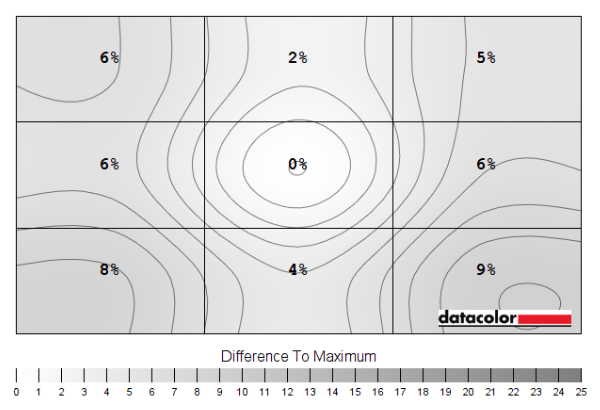
Luminance uniformity map
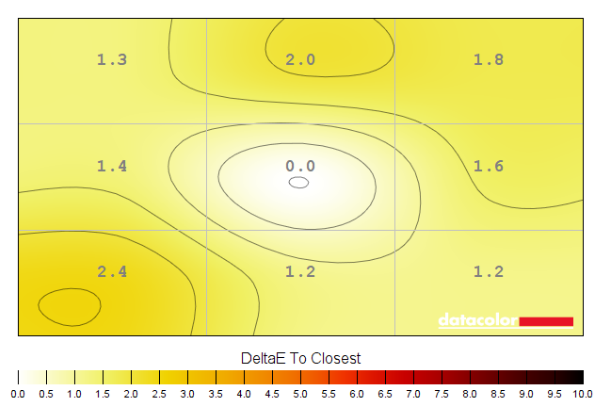
Colour temperature uniformity map
Contrast in games and movies
Lagom contrast tests
Colour reproduction
Colour gamut
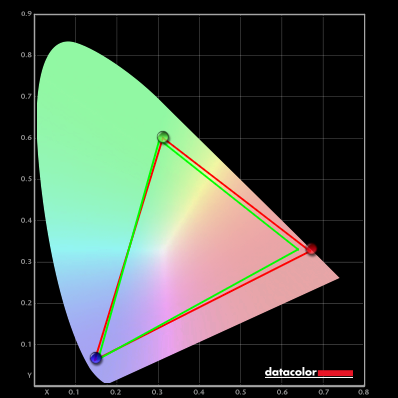
Colour gamut 'Test Settings'
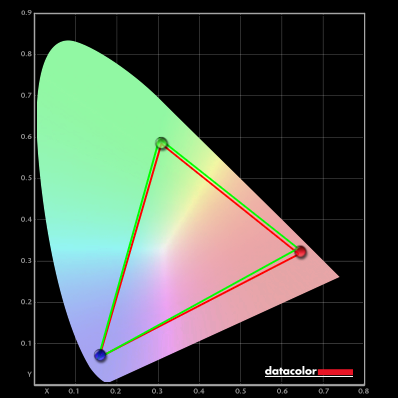
Colour gamut 'sRGB'
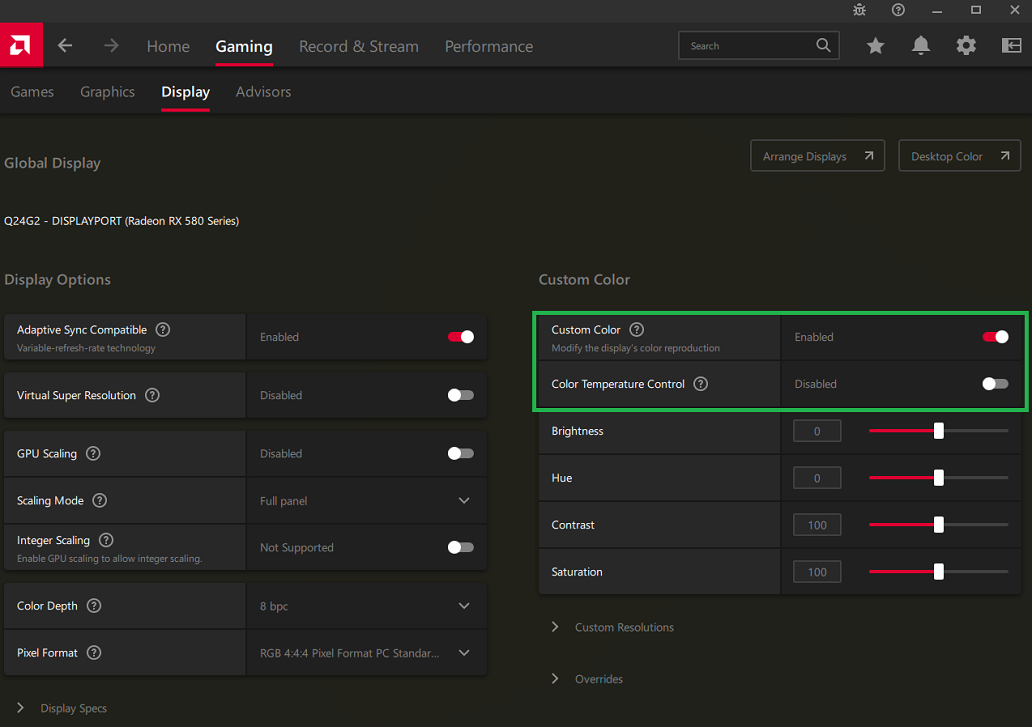
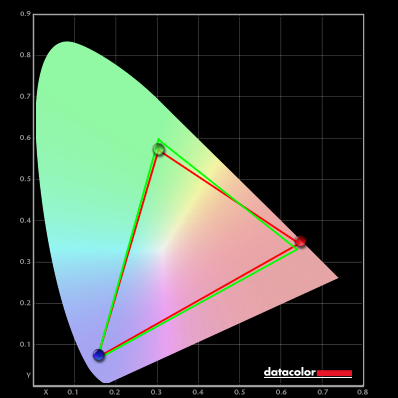
Colour gamut AMD 'CTC disabled' setting
Colour in games and movies
Shade representation using SpyderCHECKR 24

Viewing angles

The video below shows the Lagom text test, a mixed desktop background, game scene and dark desktop background from various viewing angles. The colour shifts for the mixed desktop background and game scene are relatively minor, significantly lower than you’d observe on VA or TN models. There’s some ‘hazing’ (contrast loss) from sharper angles, which is slightly more noticeable than on some IPS models – particularly horizontally. The dark desktop background highlights ‘IPS glow’, which blooms out as viewing angle increases. This appears as a warm and slightly golden or cool silver shade, depending on angle.
Interlace pattern artifacts
Responsiveness
Input lag
Perceived blur (pursuit photography)








Responsiveness in games and movies

MBR (Motion Blur Reduction)
VRR (Variable Refresh Rate) technology
FreeSync – the technology and activating it


The AOC supports a variable refresh rate range of 48 – 165Hz (48 – 144Hz via HDMI). That means that if the game is running between 48fps and 165fps (for DP), the monitor will adjust its refresh rate to match. When the frame rate rises above 165fps, the monitor will stay at 165Hz and the GPU will respect your selection of ‘VSync on’ or ‘VSync off’ in the graphics driver. With ‘VSync on’ the frame rate will not be allowed to rise above 165fps, at which point VSync activates and imposes the usual associated latency penalty. With ‘VSync off’ the frame rate is free to climb as high as the GPU will output (potentially >165fps). AMD LFC (Low Framerate Compensation) is also supported by this model, which means that the refresh rate will stick to multiples of the frame rate where it falls below the 48Hz (48fps) floor of operation for FreeSync. If a game ran at 38fps, for example, the refresh rate would be 76Hz to help keep tearing and stuttering at bay. LFC usually activated at a slightly higher refresh rate of 55Hz or just slightly below – this slightly different floor of operation makes little difference in practice. This feature is used regardless of VSync setting, so it’s only above the ceiling of operation where the VSync setting makes a difference.

Some users prefer to leave VSync enabled but use a frame rate limiter set a few frames below the maximum supported (e.g. 162fps) instead, avoiding any VSync latency penalty at frame rates near the ceiling of operation or tearing from frame rates rising above the refresh rate. If you enable the ‘Frame Counter’ feature in the ‘Game Setting’ section of the OSD, the monitor will display the refresh rate. This will coincide with the frame rate of the content if the monitor is within the main VRR window. Finally, it’s worth noting that FreeSync only removes stuttering or juddering related to mismatches between frame rate and refresh rate. It can’t compensate for other interruptions to smooth game play, for example network latency or insufficient system memory. Some game engines will also show stuttering (or ‘hitching’) for various other reasons which won’t be eliminated by the technology.
FreeSync – the experience
Nvidia Adaptive-Sync (‘G-SYNC Compatible’)

As noted previously and as highlighted in Nvidia Control Panel, this model has been specifically tested and validated as ‘G-SYNC Compatible’ by Nvidia. On our RTX 3090 the experience was very similar to what we described with FreeSync. With the technology getting rid of tearing and stuttering from what would otherwise be frame and refresh rate mismatches, within the VRR range (typically ~55Hz – 165Hz in our testing). Though an LFC-like frame to refresh multiplication technology was employed below that to keep tearing and stuttering from frame and refresh rate mismatches at bay. There was again a subtle momentary stuttering as the boundary was crossed, as we observed with our AMD GPU as well. Our suggestions regarding use of VSync also apply, but you’re using Nvidia Control Panel rather than AMD Software to control this. The setting is found in ‘Manage 3D settings’ under ‘Vertical sync’, where the final option (‘Fast’) is equivalent to AMD’s ‘Enhanced Sync’ setting. You’ll also notice ‘G-SYNC Compatible’ listed under ‘Monitor Technology’ in this section, as shown below. Make sure this is selected (it should be if you’ve set everything up correctly in ‘Set up G-SYNC’).
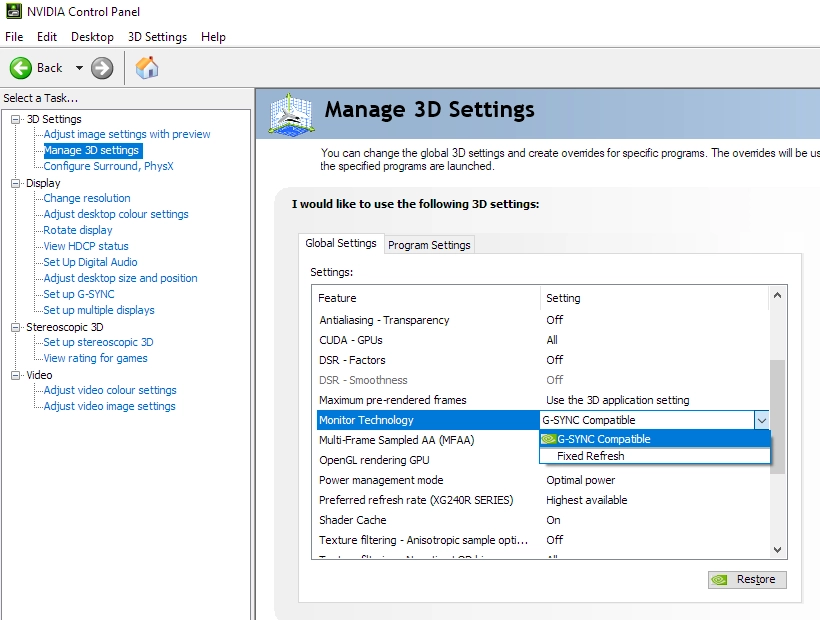
Note again that you can use the ‘Frame Counter’ feature in the ‘Game Setting’ section of the OSD to display the current refresh rate of the monitor. This will reflect the frame rate if it’s within the main variable refresh rate window.
The 23.8” QHD experience


This fairly tight pixel density provided a slight edge in detail and clarity to high resolution image and game content. This wasn’t a dramatic difference and it wasn’t the same as going up to the ‘4K’ UHD resolution on a ~32” and certainly ~27” screen, but there was still a slight edge in how crisp things appeared. Including as you look into the distance on a game for example, even if it’s a graphically ‘simple’ game or the graphics settings (resolution aside) are turned down. The smaller screen size reduces immersion from a given viewing distance, but some may prefer the more compact size. It takes up less space on the desk – which may be at a premium – and some just find larger screens a bit overwhelming or undesirable. Some favour the smaller viewing area for competitive gaming as it reduces the distance your eyes have to move and keep more of the content in your central area of vision, too. The images below show the monitor in action on various game titles. Again, the images are just for illustrative purposes and don’t accurately reflect how the monitor appears first hand.

Interpolation and upscaling
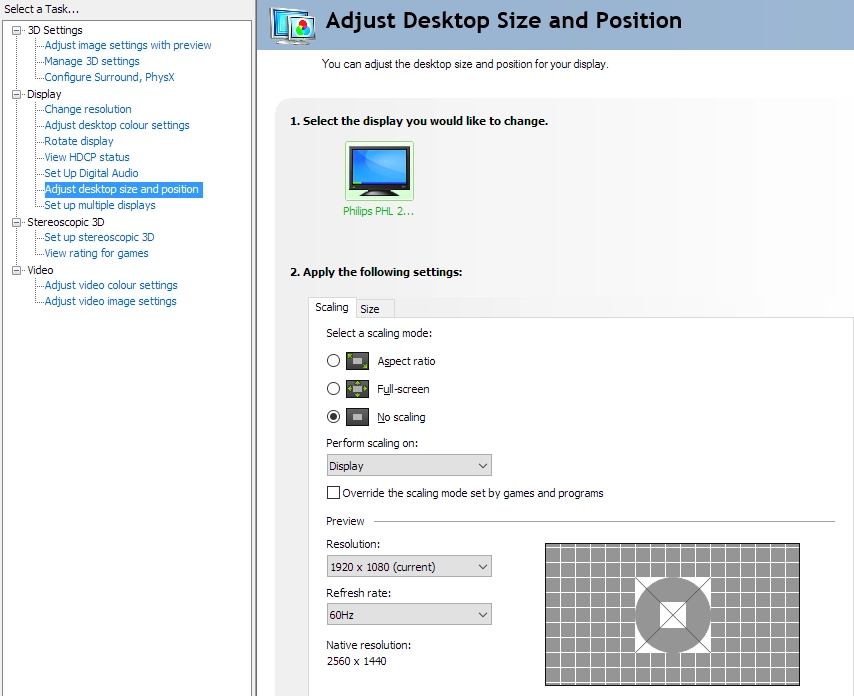
The monitor has an ‘Image Ratio’ setting in the ‘Extra’ section of the OSD, but this always seemed to be set to ‘Wide’ where interpolation was supported. We tested various resolutions and refresh rates where interpolation was supported and confirmed this was the only option, but perhaps other options are available for very specific resolution and refresh rate combinations. This default ‘Wide’ behaviour allows the monitor to use interpolation to fill up all pixels of the screen regardless of the aspect ratio of the source resolution – potentially stretching and distorting things. When running the 1920 x 1080 (Full HD or 1080p) resolution, the interpolation process provided moderate softening so things didn’t appear as crisp as they would when running a monitor of this size natively at the Full HD resolution. We actually found things appeared softer in general than when GPU is scaling is used. The monitor would’ve benefited from a sharpness control to help offset this, but that wasn’t a luxury afforded in this case. Although we didn’t measure input lag when using interpolation, even when running Full HD at 120Hz with a matching frame rate we felt a hit to latency which went beyond that provided by GPU scaling. Given this, we didn’t find the interpolation process of the monitor very good and would recommend using GPU scaling where possible.
Video review
Timestamps:
Features & Aesthetics
Contrast
Colour reproduction
Responsiveness (General)
Responsiveness (VRR)
Conclusion
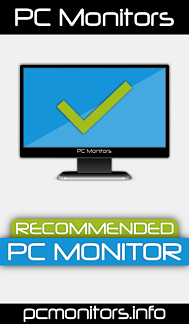
Positives Negatives The IPS-type panel and ~sRGB gamut gave a ‘rich and natural’ look that was well maintained throughout the screen
Gamma tracking off from the ‘2.2’ curve in places regardless of OSD adjustment, inflexible sRGB emulation setting with some undercoverage, no wide gamut support Reasonable static contrast (as specified) and a light matte screen surface which provided reasonably low layering and graininess in front of image Static contrast not as strong as some IPS offerings, ‘IPS glow’ ate away at depth and atmosphere, no HDR support Convincing 165Hz performance with exceptionally low input lag, well-tuned pixel responses, VRR support and a decent strobe backlight setting Minor weaknesses in pixel responsiveness for some transitions, not a true ‘single overdrive mode experience’ – though the ‘Weak’ setting still gives a decent performance throughout the VRR range The smaller screen provides a tighter pixel density than usual for the QHD resolution and helps maximise ‘desktop real estate’ even with the physical constraints, good ergonomics and excellent pricing Availability iffy in some regions and non-existent in others, at time of review, range of connectivity not as broad as some (more expensive) 27” offerings





